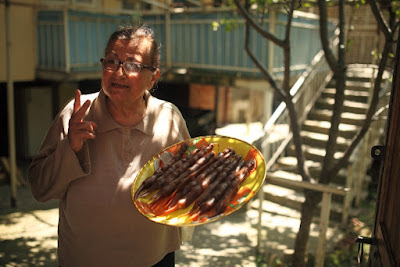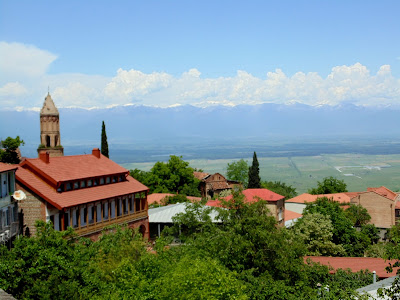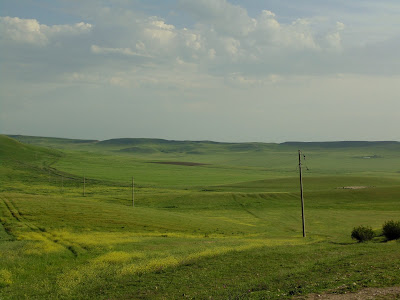Dzień 7. środa 27.05.2015
Sighnaghi - nazwa miejscowości, której nikomu nie udało się wymówić poprawnie. Było kilka wersji: Singagi, Signagi, Sihnagi... ale i oryginalną nazwę od Gruzina trudno powtórzyć: SIGHNAGHI, gdzie dźwięk "h" jest bardzo dźwięczny i "charczący".
Następnie idąc placem zagadał do nas starszy pan. Dowiedziawszy się że jesteśmy z Polski położył rękę na sercu i wyraził wielką sympatię do naszego narodu, odwołując się do sytuacji politycznej (wsparcie Gruzji przez naszego Prezydenta ŚP. Lecha Kaczyńskiego podczas wojny rosyjsko-gruzińskiej w 2008r.) i swoich doświadczeń z Polakami. (Gruzini bardzo sobie cenią nas Polaków, da się to odczuć na każdym kroku. Jest to bardzo miłe.). Mimo, że nasza komunikacja w języku rosyjskim nie była płynna, pan chętnie opowiedział nam różne ciekawostki o miasteczku oraz pokazał nam pewne miejsce, z którego było widać mur obronny Sighnaghi - niczym Chiński mur, rozległe pola winorośli i oddalone, ośnieżone pasma gór na granicy z Azerbejdżanem. Coś pięknego!
Widok na mur obronny Sighnaghi, pola winorośli i oddalone góry Kaurazu...
Następnie udałyśmy się do auta rozważając co robimy dalej. Było już ok godz 16. a przed nami jeszcze droga do Davit Gereji i do Tbilisi. Nie chciałyśmy jednak rezygnować z ostatniego punktu zwiedzania Sighnaghi: winnicy Pheasant's Tears.
To miejsce polecił mi znajomy, było ono także wyraźnie zaznaczone na mapie, a poza tym będąc w Kachetii - królestwie winnic - grzech nie odwiedzić ani jednej. Miejsce to jest przy głównej uliczce przy wjeździe do miasteczka, więc po drodze.
Winnica Pheasant's Tears jest marką win pochodzących z winogron z całego regionu Kachetii. Miejsce to jest małym muzeum, gdzie można zobaczyć ciekawe eksponaty z dziedziny winiarstwa oraz dowiedzieć się wielu ciekawostek o winach w Gruzji jak i samej sztuce wyrabiania wina.
Wstęp to koszt 15 Lari, czas wizyty - 30 min. W cenie jest zawarte oprowadzenie przez przewodnika oraz degustacja.
Po szybkim obejściu piwnicy i dwóch sal z wystawami zostałyśmy zaproszone do stołu z przygotowanymi już kieliszkami i czteroma butelkami wina. Właściciel winnicy - ów przewodnik i specjalista w tej dziedzinie, opowiedział nam krótko o działalności winnicy, sposobie wytwarzania (nie dodają cukru) oraz cechach każdego z win. Zapamiętałam, że w Gruzji jest ponad 500 odmian winorośli, dzięki zróżnicowanemu mikroklimatowi, a słynną wódkę czacza robi się ze skórki winogron. Zaciekawiona zapytałam się też, skąd pochodzi nazwa Pheasant's Tears (Łzy Bażanta). Otóż w Gruzji mówi się, że jak coś jest bardzo dobre, to smakuje jak łzy bażanta.
Winnica Pheasants' Tears
fot. Justyna Kochańska
I my ;) "Gaumardżos!"
Na trasie znajduje się tylko jedna maleńka wioska Udabno. Kilka domów i małych gospodarstw. Wioska pośród niczego. Jak wcześniej wyczytałyśmy, właśnie tam Polacy założyli knajpę "Oasis Club". Jako jedyna restauracja we wiosce jest dobrze widoczna; biały budynek z kolorowymi okiennicami, położona przy głównej - jedynej drodze. My niestety z powodu bardzo ograniczonego czasu nie zatrzymałyśmy się tam. Bałyśmy się, że wtedy dojedziemy do klasztoru po zachodzie słońca i niewiele zobaczymy. Wielka szkoda, ale pojawił się kolejny powód by wrócić do Gruzji!
- "Następnym razem dziewoszki!" - powiedziałyśmy sobie.
Za to kolejnego dnia w hostelu w Tbilisi poznałyśmy dwóch Polaków, którzy właśnie pracują w Oasis i przyjechali do stolicy zrobić zakupy - zapasy. "Ha! Co za zbieg okoliczności!" Opowiedzieli nam o tym miejscu, jak się tam żyje, pracuje ( Jeden z nich mieszkał tam cztery lata!) o tym, że otworzono hostel i ciągle przybywa turystów. Oasis - mała knajpa w biednej wiosce na "pustkowiu" promuje Udabno, Gruzję, zyskuje coraz większą popularność. Genialny pomysł! Gratulacje i powodzenia! Polak to potrafi.
Davit Gareji [czyt. Garedżi] - kompleks klasztorów w skałach pochodzący z VI- XIII w. n.e. założony przez pustelnika Davit'a Gereji gdzie znajduje się wiele kaplic, komnat i sakralnych pozostałości. Wstęp jest wolny, a wejście możliwe jest do zachodu słońca. My byliśmy tam przed siódmą wieczorem. Zdążyłyśmy obejść dziedziniec i wspiąć się na jeden z punktów widokowych przy świętym źródełku. Jest też możliwość wejścia na sam szczyt góry, gdzie przebiega granica z Azerbejdżanem. Dla nas jednak było za późno, by móc zejść jeszcze przy dziennym świetle.








































